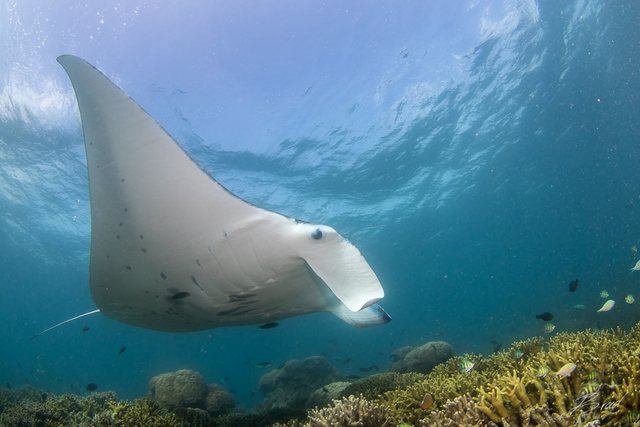Published in the Ocean Watch column, Honolulu Star-Advertiser © Susan Scott
February 25, 2017
YAP >> Because I had never been to Yap, only a one-hour flight from Palau where I had been snorkeling, I signed up for a three-day visit here. All I knew about this South Pacific island was that it had been a major World War II battle site and that we would see manta rays.
Not exactly.
 Manta rays are gentle giants that are plankton feeders, swimming forward
Manta rays are gentle giants that are plankton feeders, swimming forward
with mouths open to sift the water for food. Paddlelike flaps on each
side of the mouth direct plankton down the hatch.
Courtesy Manta Ray Bay Resort
During the war, the U.S. military did not consider Japanese-occupied Yap a strategic target. American planes were sent to bomb only island airfields. Yap residents fled to the hills while 120 American pilots and crews, and an unknown (to me) number of Japanese lost their lives in aerial fighting.
My other mistaken vision of Yap was that most people come here to dive on crashed planes. That’s part of some tours but not mine. We three snorkelers joined a boat with two divers from Germany and two from Japan, all hoping to see Yap’s manta rays.
Mantas can live 50 years. At least 50 individuals call Yap home. Resident researchers identify each fish by distinct black markings on their white bellies. Workers at my top-notch hotel, the Manta Ray Bay Resort, have posted photos and names of Yap’s well-known mantas. My favorite name is Dotcom.
These rays routinely come to certain cleaning stations, where wrasses nibble parasites off the huge kite-shaped fish. Biologists think the mantas might also congregate there to socialize, perhaps males and females flirting for a future hookup.
Mantas once had hellish reputations, their enormous sizes and black backs spooking old-time sailors, who called the fish devil rays. Most mantas are about 10 feet wide, but some can grow over 15 feet wide.
Whatever their size, the fish are harmless. Manta rays have long tails like their sting- and eagle-ray cousins with one exception: Manta tails have no stingers. Nor do mantas have teeth. Like whale sharks, these gentle giants are plankton feeders, swimming forward with mouths open to sift the water for food. Paddlelike flaps on each side of the mouth direct plankton down the hatch.
On the two days that our boat dropped us off near the cleaning stations, the mantas chose to skip hanging out there. But we snorkelers weren’t disappointed. The reef was exquisite and included some magnificent manta relatives: white-tip, black-tip and gray reef sharks. Sharks and rays are related in that their bodies contain no bones, just cartilage.
I loved Yap’s super-friendly people, entwined mangrove forests and pristine reefs. It wasn’t what I expected but that’s the beauty of travel. You get to generate your own impressions.
Don’t, though, take my word for it.